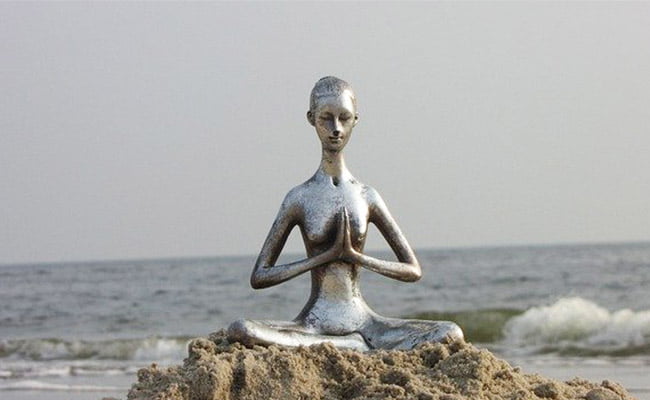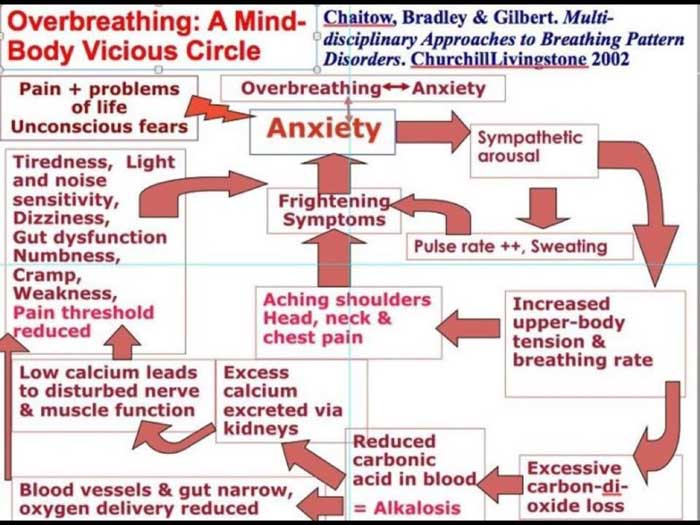Meditation is all about relaxation, and better breathing helps you access a calmer, more centered state of mind.
Additionally, research shows that several brain regions connected to emotion, attention, and body awareness are activated when we pay attention to the breath (1).
Doing so creates a state of mindfulness, of present awareness.
In this post, we'll look at one simple technique that will not only help you meditate better, but also help you sleep better and reduce feelings of anxiety and stress in everyday life.

How Incorrect Breathing Increases Stress
It sounds strange to think that something we've been doing every second since we were born could be done improperly. However, done incorrectly, breathing can increase stress and alertness.
So if you've been trying to meditate and find that the longer you close your eyes the more alert and fidgety you become, learning better breathing will really help.
When someone tells us to “breathe”, we generally associate this with fast inhalation and puffing up the chest. But this is incorrect.
You need a healthy balance between breathing in oxygen and breathing out carbon dioxide.
You shouldn't breathe too quickly, or too shallow, and you shouldn't exhale more air than you take in.
Taking in quick gulps of air (shallow breathing), and not exhaling properly, can make us feel more anxious.
When you want to relax, breath in slowly and deeply, and exhale in the same way.
Become aware of the rise and fall of your stomach, and allow your stomach to rise gently as you breathe in, and to fall gently as you breathe out.
Your breathing should be relaxed and almost silent.
Overbreathing – A Mind-Body Vicious Cycle
Overbreathing is a reaction to stress. We've all experienced symptoms at some point, such as a racing heart, butterflies in the stomach, a dry mouth or trembling.
The problem is that for some people that the traits of overbreathing can become habitual.
You may find yourself engaged with an irregular breathing pattern, or breath- holding without realizing you're doing it.
Symptoms of Overbreathing
You will know if you are overbreathing if you have one of the following symptoms:
- Greater movement of the upper chest than with normal breathing
- Erratic (irregular) breathing pattern
- A mixture of shallow and deep breaths
- Wide variations in rhythm
- Frequent sighs and yawns
- Breath holding
- Noisy breathing (2).
Overbreathing is connected to anxiety, and anxiety leads to symptoms of tension and stress.
When you overbreathe, you reduce oxygen flow in the body and may feel tired and sensitive. Overbreathing can even deplete us of calcium, and restricts our blood vessels and gut movement.
The digram below shows what happens during “overbreathing”.

A Breathing Technique to Reduce Anxiety
There is a simple technique that was once commonly used by medical professionals to help calm a person having a panic attack.
The technique seeks to regulate the flow of oxygen and carbon dioxide and bring balance to the breathing.
When a person has a panic attack, it causes them to breathe too fast, which causes the body to lose carbon dioxide (CO2).
We do need to exhale CO2, but still need a minimum amount in the bloodstream to maintain the body's pH balance – otherwise the tissues in your body can start to malfunction.
In this technique, the patient is asked to breathe through a paper bag: breathing in deeply for a count of six, and exhaling for a count of six.
Using the same air over again stops a person hyperventilating and restores carbon dioxide levels, which helps them to calm down and relax.
Have a go and try the same technique now, but without the paper bag! Breath in and count to six, and then exhale slowly for six.
If you find you are short of breath after just a few seconds, that's fine; just inhale and exhale for as long as it feels comfortable. Don't exert yourself.
If you do this 6-10 times, you will notice that you feel more relaxed. You will feel lighter, more present, and less anxious. You will also find that your brain relaxes, and that thought trails dissipate.
Psychological/behavioral outputs related to the above mentioned changes (slow breathing) are increased comfort, relaxation, pleasantness, vigor and alertness, and reduced symptoms of arousal, anxiety, depression, anger, and confusion (2).
Breathing Meditation Practice
This is exactly the same state of mind we want to cultivate when meditating – calm and fully present. Take the same principle and apply it to your meditation practice: long, deep and balanced breaths.
Focusing on the breath is a great starting point for beginners to meditation, and is practiced in many mindful meditation disciplines.
You can also practice a breathing meditation when standing, walking around, or for just a few minutes at your desk while you take a break from work. You don't have to be sat in the lotus position for half an hour to benefit.
Making this a daily practice is highly beneficial. Shifting your mind into this state each day will encourage being calm and balanced as a habitual behavior.
It is also a great way to practice breathing properly and to overcome symptoms of overbreathing and bad breathing in general.
6-Step Breathing Meditation Plan
- Start with 5 minutes a day, then gradually progress to 10, 20, and eventually a full 30-minute meditation.
- Find a quiet place, free from distraction. Turn off the TV and radio and put your phone on silent for the duration.
- If you plan to do your deep breathing while walking, then use your garden or go to the park.
- If you want to be seated, find a quiet room in the house with a comfortable floor or chair. You can also use a yoga mat.
- You can close your eyes or keep them open. If open, try to fixate on an object in the room, or simply stare at a spot on the floor around 1.5m in front of you.
- Breath in slowly and deeply and exhale fully. Try to make the in and out flow a count of six. Literally watch your breath as it enters and exits your body.
Note: You can do your breathing meditation while listening to meditation music. For some it helps to have headphones in, as this eliminates outside noise.
Deep Breathing to Fall Asleep
For those who have trouble falling asleep, focussing on the breath is a helpful way to overcome insomnia.
The autonomic nervous system is integral to sleep initiation, maintenance, and disruption, and by using slow, deep breathing, you can attenuate autonomic hyper-arousal and be more relaxed when it is time to sleep.
One study of available evidence concluded:
We present a viewpoint on the treatment of insomnia that techniques of slow, deep breathing (0.1 Hz) in adjunct to sleep hygiene and relaxation therapies may be highly effective in initiating sleep as well as facilitating falling back asleep (3).
Deep breathing, as described above, can be done before you get into bed, as part of a sleep hygiene ritual, or in bed while lying down and closing your eyes. Regular practice will entrain the brain with an association between being in bed and feeling relaxed.
This is another example of how using the breath can positively impact health.
In Summary
It is easy to forget that control and awareness of the breath is important for better performance and well-being in many areas of life:
- Runners use controlled breathing to maximize oxygen intake and maintain relaxation
- Singers use special breathing techniques to warm up and to get the most out of their vocal range
- Performers temper nerves with breathing exercises
- Deeper, longer breathing can be used as a tool to help manage your thoughts, moods, and experiences, and as a way to assist meditation and sleep.
However, due to an increasingly sedentary existence, we spend less time using the breath to our advantage and more time shallow breathing – tending to take small, quick gulps of air and not exhaling properly.
This isn't good for our health. We should exercise the breath like a muscle and use it to properly stimulate the respiratory system and our organs.
During your next meditation session, try focusing on your breath and using the breathing technique set out above.
When you become one with your breath and strike a harmonious balance, you'll be amazed at how quickly the mind comes to centre, and how much easier it is to access a state of present awareness.






